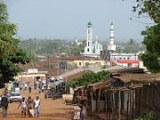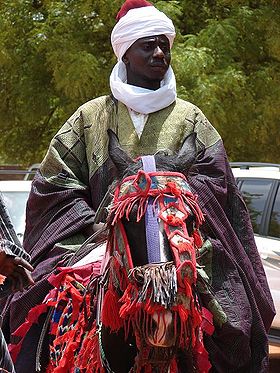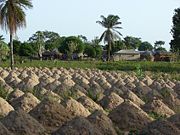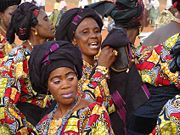
Sokodé
Encyclopedia
Sokodé is the second largest city in Togo
and seat of the Tchaoudjo
and Centrale Region
in the center of the country, 339 kilometres (210.6 mi) north of Lomé
. With a population of 86,500 (2004), currently at around 113,000, the city is situated between the Mo
and Mono
rivers, and it is a commercial center for the surrounding agricultural areas. It is a multi-ethnic and multi-religious city, but is dominated by Islam
.
, from the eastern part of the Niger Bend
, between Ouagadougou
and Niamey
, which brought into the political chiefdoms. In this structure, traders and craftsmen Sudan (the Mandinka
, from historic Mali
) and Hausa
added from the 16th century a dynamic force, which will be the success of the city: Islam , and with it the sense of cases related to trade relations. By choosing in late 1897, to install a post Sokodé, German
s endorse the role of such chefferies Kotokoli.
The city has thus developed in precolonial times as a commercial crossroads on the road to the cola
between Ghana
and Benin
, and now as a place of passage on the only road north-south Togo, linking the capital Lome in Burkina Faso
. Urbanization has accelerated during the colonization. The city consists of ancient villages have now become real neighborhoods. Its growth has also been the work of entire villages that had approached the city and intercity migration.
 Sokodé is still handled by the City complementary and traditional chiefs. Historically, the Chiefs of various villages were included in a leadership supreme, Tchaoudjo. At each change of reign, the new sovereign was to be taken, in turn, in another place (always among the constituent villages, seven). These are the Tchalo of Daro, a village south of Sokodé, who were responsible for the choice of new leaders. Muslims Didaouré remained out of this political construction, and enjoy broad autonomy, led by a leader of Muslims (uro-MALWA), always from the patronymic group tour and under the direct responsibility of the supreme leader. Today, the head of Komah assumes the supreme role.
Sokodé is still handled by the City complementary and traditional chiefs. Historically, the Chiefs of various villages were included in a leadership supreme, Tchaoudjo. At each change of reign, the new sovereign was to be taken, in turn, in another place (always among the constituent villages, seven). These are the Tchalo of Daro, a village south of Sokodé, who were responsible for the choice of new leaders. Muslims Didaouré remained out of this political construction, and enjoy broad autonomy, led by a leader of Muslims (uro-MALWA), always from the patronymic group tour and under the direct responsibility of the supreme leader. Today, the head of Komah assumes the supreme role.
. The border between the Mono and the Volta River
drainage basin
s is located a few kilometers north of the city. It is now in the catchment of the river Mô
.
 Sokodé is the city with the highest proportion of Muslim population of Togo. 70% of the population is Muslim, 30% were Christian
Sokodé is the city with the highest proportion of Muslim population of Togo. 70% of the population is Muslim, 30% were Christian
s, mostly Catholic
s. Sokodé is home to the Tem people and most people in Sokodé speak Kotokoli (or tem). The ethnonym Kotokoli is the name that was given to these speakers by traders of the Niger Bend. Many other languages are spoken in Togo, especially ewé
, the dominant language of the south, and Kabyé
, dominant language of the Kara region
, further north. The Kotokoli and Kabyè languages are closely related.
From the standpoint of habitat, we can divide the city into two parts: the center, with a very high density housing, traditional, and the suburbs, housing less and less dense as one moves away from the center. Modern materials have been increasingly replacing traditional materials (mudbrick
) if it follows the same progression.
is 26 °C (1961–1990). The evaporation
is high, estimated at 1500 mm / year, and is particularly marked in harmattan period from November to January. The humidity
is very variable, and depends on all the above factors.
 Today, the economy Sokodé is dominated by transport, trade and handicrafts. There is no industrial activity.
Today, the economy Sokodé is dominated by transport, trade and handicrafts. There is no industrial activity.
Farmers grow primarily corn
, cassava
, yams
, pepper
and beans, and many gardeners and farmers live on the periphery of Sokodé. The farmers are for the most part of the ethnic Fulani , many of whom have settled around Sokodé. They have herds of cows in the fields. Meanwhile, nomadic Fulani frequently pass near Sokodé, with their herds of zebu en route between Burkina Faso and Nigeria.
The vegetables are grown especially along the rivers Kpondjo and Inusayo. Most areas of gardening are floodplains; with growers beginning to cultivate after the rainy season.
 'Gadao-Terraced-Kosso: The Day Kotokoli. Three days of festivities, from Friday to Sunday. Celebrated the eve affiliations, Gadao's function is to thank the ancestors for abundant harvests. Terraced, or Feast of knives, is a festival of discovery dating back to semassiwarriorswho were exercising their power and bravery in undergoing tests forces. The next day Kosso place, the party of women, as these come in on the ground Sokodé City. In 2008, this celebration took place in late March.
'Gadao-Terraced-Kosso: The Day Kotokoli. Three days of festivities, from Friday to Sunday. Celebrated the eve affiliations, Gadao's function is to thank the ancestors for abundant harvests. Terraced, or Feast of knives, is a festival of discovery dating back to semassiwarriorswho were exercising their power and bravery in undergoing tests forces. The next day Kosso place, the party of women, as these come in on the ground Sokodé City. In 2008, this celebration took place in late March.
Among others, major festivals are held by different Sokodé clans . In most festivals traditional dancers are invited in the region, as well as riders mimicking the Semassi warriors, spinning at full speed in the middle of the crowd.
who play at the Stade Municipal
as do the Tchaoudjo Athlétic Club
.

Togo
Togo, officially the Togolese Republic , is a country in West Africa bordered by Ghana to the west, Benin to the east and Burkina Faso to the north. It extends south to the Gulf of Guinea, on which the capital Lomé is located. Togo covers an area of approximately with a population of approximately...
and seat of the Tchaoudjo
Tchaoudjo
Tchaoudjo is a prefecture located in the Centrale Region of Togo. The capital city is Sokodé....
and Centrale Region
Centrale Region
Centrale is one of Togo's five regions. Sokodé is the regional capital. It is the smallest region in terms of population.Other major cities in the Centrale region include Tchamba and Sotouboua....
in the center of the country, 339 kilometres (210.6 mi) north of Lomé
Lomé
Lomé, with an estimated population of 737,751, is the capital and largest city of Togo. Located on the Gulf of Guinea, Lomé is the country's administrative and industrial center and its chief port. The city exports coffee, cocoa, copra, and palm kernels...
. With a population of 86,500 (2004), currently at around 113,000, the city is situated between the Mo
Mo River
The Mo River is a river of Togo and Ghana. It arises in Togo and flows west, forming a short part of the international boundary between Togo and Ghana. It empties into Lake Volta....
and Mono
Mono River
The Mono River is the major river of eastern Togo.Approximately long, and draining a basin of about , it rises between the town of Sokodé and the border with Benin, and flows south. Along the southern portion of the river towards its mouth, it forms the international boundary between Togo and Benin...
rivers, and it is a commercial center for the surrounding agricultural areas. It is a multi-ethnic and multi-religious city, but is dominated by Islam
Islam
Islam . The most common are and . : Arabic pronunciation varies regionally. The first vowel ranges from ~~. The second vowel ranges from ~~~...
.
History
Old indigenous strains of the region are mixed in a first-time immigrants GurmaGurma
Gourma redirects here. For the Burkina Faso province, see Gourma Province.Gurma is an ethnic group living mainly in Burkina Faso, around Fada N'Gourma, and also in northern areas of Togo and Benin, as well as southwestern Niger...
, from the eastern part of the Niger Bend
Niger River
The Niger River is the principal river of western Africa, extending about . Its drainage basin is in area. Its source is in the Guinea Highlands in southeastern Guinea...
, between Ouagadougou
Ouagadougou
Ouagadougou is the capital of Burkina Faso and the administrative, communications, cultural and economic center of the nation. It is also the country's largest city, with a population of 1,475,223 . The city's name is often shortened to Ouaga. The inhabitants are called ouagalais...
and Niamey
Niamey
-Population:While Niamey's population has grown steadily since independence, the droughts of the early 1970s and 1980s, along with the economic crisis of the early 1980s, have propelled an exodus of rural inhabitants to Niger's largest city...
, which brought into the political chiefdoms. In this structure, traders and craftsmen Sudan (the Mandinka
Mandinka people
The Mandinka, Malinke are one of the largest ethnic groups in West Africa with an estimated population of eleven million ....
, from historic Mali
Mali Empire
The Mali Empire or Mandingo Empire or Manden Kurufa was a West African empire of the Mandinka from c. 1230 to c. 1600. The empire was founded by Sundiata Keita and became renowned for the wealth of its rulers, especially Mansa Musa I...
) and Hausa
Hausa people
The Hausa are one of the largest ethnic groups in West Africa. They are a Sahelian people chiefly located in northern Nigeria and southeastern Niger, but having significant numbers living in regions of Cameroon, Ghana, Cote d'Ivoire, Chad and Sudan...
added from the 16th century a dynamic force, which will be the success of the city: Islam , and with it the sense of cases related to trade relations. By choosing in late 1897, to install a post Sokodé, German
German colonial empire
The German colonial empire was an overseas domain formed in the late 19th century as part of the German Empire. Short-lived colonial efforts by individual German states had occurred in preceding centuries, but Imperial Germany's colonial efforts began in 1884...
s endorse the role of such chefferies Kotokoli.
The city has thus developed in precolonial times as a commercial crossroads on the road to the cola
Kola nut
Kola Nut is the nut of the kola tree, a genus of trees native to the tropical rainforests of Africa, classified in the family Malvaceae, subfamily Sterculioideae . It is related to the South American genus Theobroma, or cocoa...
between Ghana
Ghana
Ghana , officially the Republic of Ghana, is a country located in West Africa. It is bordered by Côte d'Ivoire to the west, Burkina Faso to the north, Togo to the east, and the Gulf of Guinea to the south...
and Benin
Benin
Benin , officially the Republic of Benin, is a country in West Africa. It borders Togo to the west, Nigeria to the east and Burkina Faso and Niger to the north. Its small southern coastline on the Bight of Benin is where a majority of the population is located...
, and now as a place of passage on the only road north-south Togo, linking the capital Lome in Burkina Faso
Burkina Faso
Burkina Faso – also known by its short-form name Burkina – is a landlocked country in west Africa. It is surrounded by six countries: Mali to the north, Niger to the east, Benin to the southeast, Togo and Ghana to the south, and Côte d'Ivoire to the southwest.Its size is with an estimated...
. Urbanization has accelerated during the colonization. The city consists of ancient villages have now become real neighborhoods. Its growth has also been the work of entire villages that had approached the city and intercity migration.

Geography
Sokodé is characterized by a dense network of rivers and relief hills. The two main rivers are the Kpondjo and Kpandi, which flow into the Na. The latter resulted in the Mono RiverMono River
The Mono River is the major river of eastern Togo.Approximately long, and draining a basin of about , it rises between the town of Sokodé and the border with Benin, and flows south. Along the southern portion of the river towards its mouth, it forms the international boundary between Togo and Benin...
. The border between the Mono and the Volta River
Volta River
The Volta is a river in western Africa that drains into the Gulf of Guinea. It has three main tributaries—the Black Volta, White Volta and Red Volta...
drainage basin
Drainage basin
A drainage basin is an extent or an area of land where surface water from rain and melting snow or ice converges to a single point, usually the exit of the basin, where the waters join another waterbody, such as a river, lake, reservoir, estuary, wetland, sea, or ocean...
s is located a few kilometers north of the city. It is now in the catchment of the river Mô
Mo River
The Mo River is a river of Togo and Ghana. It arises in Togo and flows west, forming a short part of the international boundary between Togo and Ghana. It empties into Lake Volta....
.
Demographics

Christianity
Christianity is a monotheistic religion based on the life and teachings of Jesus as presented in canonical gospels and other New Testament writings...
s, mostly Catholic
Catholicism
Catholicism is a broad term for the body of the Catholic faith, its theologies and doctrines, its liturgical, ethical, spiritual, and behavioral characteristics, as well as a religious people as a whole....
s. Sokodé is home to the Tem people and most people in Sokodé speak Kotokoli (or tem). The ethnonym Kotokoli is the name that was given to these speakers by traders of the Niger Bend. Many other languages are spoken in Togo, especially ewé
Ewe language
Ewe is a Niger–Congo language spoken in Ghana, Togo and Benin by approximately six million people. Ewe is part of a cluster of related languages commonly called Gbe, spoken in southeastern Ghana, Togo, and parts of Benin. Other Gbe languages include Fon, Gen, Phla Phera, and Aja...
, the dominant language of the south, and Kabyé
Kabiyé language
Kabiyè is a Grusi language spoken primarily in northern Togo, and also by smaller numbers of people in Benin and Ghana. It is one of two national languages of Togo.-References:-External links:**...
, dominant language of the Kara region
Kara Region
Kara is one of Togo's five regions. Kara is the regional capital.Other major cities in the Kara region include Bafilo, Bassar, and Niamtougou.Kara is divided into the prefectures of Assoli, Bassar, Bimah, Dankpen, Doufelgou, Kéran, and Kozah....
, further north. The Kotokoli and Kabyè languages are closely related.
From the standpoint of habitat, we can divide the city into two parts: the center, with a very high density housing, traditional, and the suburbs, housing less and less dense as one moves away from the center. Modern materials have been increasingly replacing traditional materials (mudbrick
Mudbrick
A mudbrick is a firefree brick, made of a mixture of clay, mud, sand, and water mixed with a binding material such as rice husks or straw. They use a stiff mixture and let them dry in the sun for 25 days....
) if it follows the same progression.
Climate and economy
Located at an average altitude of 340 m, midway between the ocean and the Sahel strip, Sokodé enjoys tropical climate, with two marked seasons: the rainy season, which lasts from April to October, with a peak from July to September and the dry season from November to March. The rainfall is between 1,200 and 1,500 mm per year and the number of rainy days varies between 100 and 130. The average temperatureTemperature
Temperature is a physical property of matter that quantitatively expresses the common notions of hot and cold. Objects of low temperature are cold, while various degrees of higher temperatures are referred to as warm or hot...
is 26 °C (1961–1990). The evaporation
Evaporation
Evaporation is a type of vaporization of a liquid that occurs only on the surface of a liquid. The other type of vaporization is boiling, which, instead, occurs on the entire mass of the liquid....
is high, estimated at 1500 mm / year, and is particularly marked in harmattan period from November to January. The humidity
Humidity
Humidity is a term for the amount of water vapor in the air, and can refer to any one of several measurements of humidity. Formally, humid air is not "moist air" but a mixture of water vapor and other constituents of air, and humidity is defined in terms of the water content of this mixture,...
is very variable, and depends on all the above factors.

Farmers grow primarily corn
Maize
Maize known in many English-speaking countries as corn or mielie/mealie, is a grain domesticated by indigenous peoples in Mesoamerica in prehistoric times. The leafy stalk produces ears which contain seeds called kernels. Though technically a grain, maize kernels are used in cooking as a vegetable...
, cassava
Cassava
Cassava , also called yuca or manioc, a woody shrub of the Euphorbiaceae native to South America, is extensively cultivated as an annual crop in tropical and subtropical regions for its edible starchy tuberous root, a major source of carbohydrates...
, yams
Yam (vegetable)
Yam is the common name for some species in the genus Dioscorea . These are perennial herbaceous vines cultivated for the consumption of their starchy tubers in Africa, Asia, Latin America and Oceania...
, pepper
Capsicum
Capsicum is a genus of flowering plants in the nightshade family, Solanaceae. Its species are native to the Americas where they have been cultivated for thousands of years, but they are now also cultivated worldwide, used as spices, vegetables, and medicines - and have become are a key element in...
and beans, and many gardeners and farmers live on the periphery of Sokodé. The farmers are for the most part of the ethnic Fulani , many of whom have settled around Sokodé. They have herds of cows in the fields. Meanwhile, nomadic Fulani frequently pass near Sokodé, with their herds of zebu en route between Burkina Faso and Nigeria.
The vegetables are grown especially along the rivers Kpondjo and Inusayo. Most areas of gardening are floodplains; with growers beginning to cultivate after the rainy season.
Festivals

Among others, major festivals are held by different Sokodé clans . In most festivals traditional dancers are invited in the region, as well as riders mimicking the Semassi warriors, spinning at full speed in the middle of the crowd.
Sport
The town is home to AC Semassi F.C.AC Semassi F.C.
AC Semassi F.C. is a Togolese football club based in Sokodé. They play in the top division in Togolese football. Their home stadium is Stade Municipal.-Achievements:*Togolese Championnat National: 9*Coupe du Togo: 3...
who play at the Stade Municipal
Stade Municipal (Sokodé)
Stade Municipal is a multi-use stadium in Sokodé, Togo. It is currently used mostly for football matches and is the home stadium of AC Semassi F.C. and Tchaoudjo Athlétic Club. The stadium holds 10,000 people....
as do the Tchaoudjo Athlétic Club
Tchaoudjo Athlétic Club
Tchaoudjo Athlétic Club is a Togolese football club based in Sokodé. They play in the top division in Togolese football. Their home stadium is Stade Municipal.-Current squad:...
.
Notable people

- Kotokro - the founder of Sokodé.
- Zarifou AyévaZarifou AyévaZarifou Ayéva is a Togolese politician and the President of the Party for Democracy and Renewal . He served in the government of Togo as a minister during the 1970s and became an opposition leader in the early 1990s...
-politician - Mohamed KaderMohamed KaderMohamed Abdel-Kader Coubadja-Touré is a Togolese football striker.-International career:A Togo international, he helped them reach the 2006 World Cup, their first World Cup ever. He further scored the team's first ever World Cup goal in a loss to South Korea. The goal was also Togo's only goal...
-footballer - Edem KodjoEdem KodjoÉdouard Kodjovi Kodjo, better known as Edem Kodjo , is a Togolese politician and diplomat. He was Secretary-General of the Organization of African Unity from 1978 to 1983; later, in Togo, he was a prominent opposition leader after the introduction of multiparty politics. He served as Prime...
- former Prime Minister of Togo - Assimiou TouréAssimiou TouréAssimiou Touré is a Togolese football defender. He currently plays for Arminia Bielefeld. He also holds a German passport.-Career:...
-footballer

